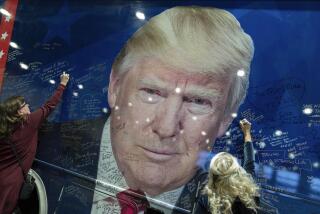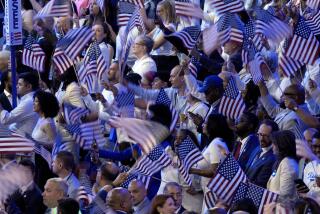Are Political Buttons Pins of the Past?
- Share via
WASHINGTON — Here’s one more thing to blame on television.
Campaign buttons, those once ubiquitous artifacts of American politics, could be headed to the endangered species list.
“Every dollar you spend on a button is a dollar you can’t spend on TV,” said a campaign aide to Sen. Alfonse D’Amato, summing up the thinking of the modern-day political advisor.
D’Amato, a New York Republican, lost his reelection bid last month in a contest that saw few political buttons. D’Amato’s camp distributed only a few, and the winner, Democratic Congressman Charles Schumer, had no buttons at all made for his campaign.
The people who make and collect campaign buttons say the little pin-on disks bearing photos and slogans probably won’t go the way of the dinosaur, mainly because many voters still want and expect them.
But buttons and other traditional campaign trinkets--like combs and hats, nail files and fans--have been shunted aside in many of today’s cash-fueled elections.
“I’m convinced they’d prefer to spend all of their money on television because they think that has some measurable effect,” said Larry Bird, curator of the political history collection at the Smithsonian Institution’s National Museum of American History.
“But to my sensibility, there’s something inherently democratic about these low-tech novelties,” Bird said.
Buttons and similar doodads have been part of American politics from the start. The Smithsonian’s collection includes brass coat buttons made to commemorate George Washington’s first inauguration.
Many political artifacts--especially those associated with the early presidents--celebrated, rather than promoted, the presidency.
During the 1880s, likenesses of presidential faces adorned all manner of cups and bowls, silver spoons and pin boxes. There was even a shaving mug and straight razor made to honor “Old Zac,” Zachary Taylor.
But as the modern two-party system began to emerge, candidate advocacy quickly replaced adulation.
In Andrew Jackson’s 1824 campaign, tokens, struck with a crude image of Old Hickory on one side and slogans like “The Nation’s Good” on the other, were worn as watch fobs.
Utilitarian presidential souvenirs--treasures like sewing boxes and hairbrushes--gave way in large part to truly ephemeral mass-produced objects such as banners, badges, pin-back buttons and ribbons.
Collectors weren’t far behind, and today thousands of American political buffs have boxes filled with memorabilia. The tradition is kept alive by small entrepreneurs who peddle political trinkets at conventions and major campaign events.
It’s “one of the most American of all the collecting hobbies,” said Larry Krug, executive director of the American Political Items Collectors. “It really does give you a sense of history and . . . a piece of history.”
The heyday of the political button, says Bird of the Smithsonian, was President Eisenhower’s 1952 campaign, when those little “I Like Ike” buttons seemed ubiquitous.
Kennedy buttons were popular in 1960, and sales soared again in 1992 when Bill Clinton first ran for the White House.
Many of those buttons were the product of the N.G. Slater Corp., a small, family-run business on Manhattan’s West Side.
Founded in 1936 by Nathaniel George Slater and operated today by his two sons, Robert and Alan, the 50-employee company is one of the country’s largest manufacturers of campaign buttons, bumper stickers, lawn signs and hats.
These days the company produces mostly buttons and novelty items for business promotions.
Robert Slater says he’s watched the trend away from political buttons, but he’s not too worried.
“It’s cyclical. They’ll come back again,” he said. “If you’ve got a very popular candidate, people want to have keepsakes. You obviously can’t keep a TV commercial.”
More to Read
Get the L.A. Times Politics newsletter
Deeply reported insights into legislation, politics and policy from Sacramento, Washington and beyond. In your inbox twice per week.
You may occasionally receive promotional content from the Los Angeles Times.










